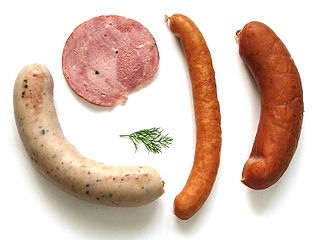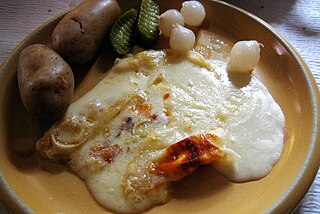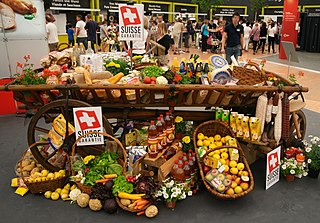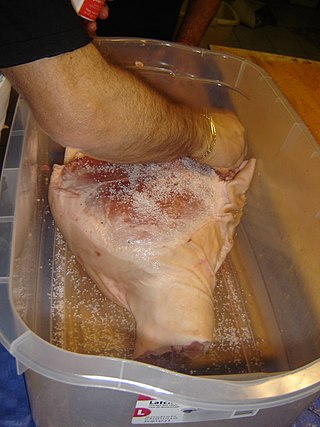
A sausage is a type of meat product usually made from ground meat—often pork, beef, or poultry—along with salt, spices and other flavourings. Other ingredients, such as grains or breadcrumbs may be included as fillers or extenders.

Raclette is a Swiss dish, also popular in the other Alpine countries, based on heating cheese and scraping off the melted part, then typically served with boiled potatoes. Raclette cheese is historically a dish originating from the canton of Valais in Switzerland. This cheese from Valais benefits from an AOP. Raclette cheese is also a Swiss-type cheese marketed specifically to be used for this dish.

The cuisine of Québec is a national cuisine in the Canadian province of Québec. It is also cooked by Franco-Ontarians.

Prosciutto crudo, in English often shortened to prosciutto, is uncooked, unsmoked, and dry-cured ham. Prosciutto crudo is usually served thinly sliced.

Swiss cuisine is an ensemble of national, regional and local dishes, consisting of the ingredients, recipes and cooking techniques developed in Switzerland or assimilated from other cultures, particularly neighboring countries. The diversity and comprehensiveness of Swiss gastronomy reflects the linguistic, cultural and geographical diversity. The climate of Switzerland allows for a large variety of terroirs, and therefore a wide range of indigenous food, from simple cereals to refined products like cheese and wine.

Bresaola is air-dried, salted beef that has been aged two or three months until it becomes hard and turns a dark red, almost purple color. It is made from top (inside) round, and it is lean and tender, with a sweet, musty smell. It originated in Valtellina, a valley in the Alps of northern Italy's Lombardy region.

Bündnerfleisch, also known as Bindenfleisch, Grisons Meat or Viande des Grisons, is an air-dried meat that is produced in the canton of Graubünden, Switzerland.

Curing is any of various food preservation and flavoring processes of foods such as meat, fish and vegetables, by the addition of salt, with the aim of drawing moisture out of the food by the process of osmosis. Because curing increases the solute concentration in the food and hence decreases its water potential, the food becomes inhospitable for the microbe growth that causes food spoilage. Curing can be traced back to antiquity, and was the primary method of preserving meat and fish until the late 19th century. Dehydration was the earliest form of food curing. Many curing processes also involve smoking, spicing, cooking, or the addition of combinations of sugar, nitrate, and nitrite.

Salumi are Italian meat products typical of an antipasto, predominantly made from pork and cured. Salumi also include bresaola, which is made from beef, and some cooked products, such as mortadella and prosciutto cotto.

Saucisson, also saucisson sec or saucisse sèche, is a family of thick, dry-cured sausages in French cuisine. Typically made of pork, or a mixture of pork and other meats, saucisson are a type of charcuterie similar to salami or summer sausage.

A galette-saucisse is a type of French street food item consisting of a hot sausage, traditionally grilled, wrapped in a type of crepe called galette de sarrasin or Breton galette. The French region known as Upper Brittany is the traditional homeland of galette-saucisse, especially the department of Ille-et-Vilaine and some parts of its bordering departments like Côtes-d'Armor, Morbihan, Loire-Atlantique, Mayenne and Manche.

In Switzerland, the appellation d'origine protégée is a geographical indication protecting the origin and the quality of traditional food products other than wines.

Maluns are a traditional dish of the Grisons, essentially made of potatoes.

The St. Galler Bratwurst, also known as the Olma Bratwurst after OLMA is a sausage produced in Northeastern Switzerland. It is partly made with veal and has a white color. It is named after the city of St. Gallen.

Papet Vaudois is a dish originating in the Swiss canton of Vaud. It essentially consists of leeks and potatoes and is accompanied by sausages. It is often considered to be the national dish of Vaud; the potatoes and leeks happen to have the same colors as the cantonal flag: white and green.

Salame ticinese is a variety of salami originating in Ticino, the southernmost region of Switzerland. It is characterized by coarsely ground meat and it is often made into small sausages, called salametti. It is an emblematic air-dried cured pork meat of Ticino, along with prosciutto crudo and coppa. These are referred to as salumi.

Salsiz is a raw sausage originating in the Grisons. It is an air-dried or smoked sausage and it is produced in many different variants. It distinguishes itself from most other sausages by its rectangular profile.



















